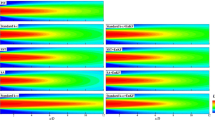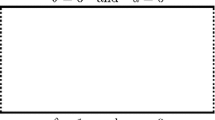Abstract
We investigate the capabilities of Physics-Informed Neural Networks (PINNs) to reconstruct turbulent Rayleigh–Bénard flows using only temperature information. We perform a quantitative analysis of the quality of the reconstructions at various amounts of low-passed-filtered information and turbulent intensities. We compare our results with those obtained via nudging, a classical equation-informed data assimilation technique. At low Rayleigh numbers, PINNs are able to reconstruct with high precision, comparable to the one achieved with nudging. At high Rayleigh numbers, PINNs outperform nudging and are able to achieve satisfactory reconstruction of the velocity fields only when data for temperature is provided with high spatial and temporal density. When data becomes sparse, the PINNs performance worsens, not only in a point-to-point error sense but also, and contrary to nudging, in a statistical sense, as can be seen in the probability density functions and energy spectra.
Graphical abstract
Visualizations of temperature (top) and vertical velocity (bottom) for the flow with \(\textrm{Ra}_2\). The left column shows the reference data, the other three columns show the reconstructions obtained with \(\ell /\delta = 1\), 14 and 31. The locations of the measuring probes (corresponding to the case with \(\ell =14\delta \)) are marked with white dots on top of \(T^r\). All visualizations share the same colorbar








Similar content being viewed by others
Data availability
The datasets generated during and/or analyzed during the current study are available from the corresponding author on reasonable request.
References
D.L. Hartmann, L.A. Moy, Q. Fu, Tropical convection and the energy balance at the top of the atmosphere. J. Clim. 14(24), 4495–4511 (2001)
K. Suselj, M.J. Kurowski, J. Teixeira, A unified eddy-diffusivity/mass-flux approach for modeling atmospheric convection. J. Atmos. Sci. 76(8), 2505–2537 (2019)
K. Våge, L. Papritz, L. Håvik, M.A. Spall, G.W.K. Moore, Ocean convection linked to the recent ice edge retreat along east Greenland. Nat. Commun. 9(1), 1–8 (2018)
B.A. Storer, M. Buzzicotti, H. Khatri, S.M. Griffies, H. Aluie, Global energy spectrum of the general oceanic circulation. Nat. Commun. 13(1), 5314 (2022)
M. Kronbichler, T. Heister, W. Bangerth, High accuracy mantle convection simulation through modern numerical methods. Geophys. J. Int. 191(1), 12–29 (2012)
A. Brent, V.R. Voller, K. Reid, Enthalpy-porosity technique for modeling convection-diffusion phase change: application to the melting of a pure metal. Numer. Heat Transf. Part A Appl. 13(3), 297–318 (1988)
G. Ahlers, S. Grossmann, D. Lohse, Heat transfer and large scale dynamics in turbulent Rayleigh–Bénard convection. Rev. Mod. Phys. 81, 503–537 (2009)
J. Charney, M. Halem, R. Jastrow, Use of incomplete historical data to infer the present state of the atmosphere. J. Atmos. Sci. 26, 1160–1163 (1969)
M. Ghil, B. Shkoller, V. Yangarber, A balanced diagnostic system compatible with a barotropic prognostic model, in Monthly Weather Review, vol. 105, Oct (Publisher: American Meteorological Society Section: Monthly Weather Review, 1977), pp. 1223–1238
M. Ghil, M. Halem, R. Atlas, Time-continuous assimilation of remote-sounding data and its effect an weather forecasting, in Monthly Weather Review, vol. 107 (Publisher: American Meteorological Society Section: Monthly Weather Review, 1979), pp. 140–171
A. Farhat, E. Lunasin, E. Titi, On the Charney conjecture of data assimilation employing temperature measurements alone: the paradigm of 3d planetary geostrophic model. Math. Clim. Weather Forecast. 2, 08 (2016)
M.U. Altaf, E.S. Titi, T. Gebrael, O.M. Knio, L. Zhao, M.F. McCabe, I. Hoteit, Downscaling the 2D Bénard convection equations using continuous data assimilation. Comput. Geosci. 21, 393–410 (2017)
M.A.E.R. Hammoud, E.S. Titi, I. Hoteit, O. Knio, CDAnet: a physics-informed deep neural network for downscaling fluid flows. J. Adv. Model. Earth Syst. 14(12), e2022MS003051 (2022). https://doi.org/10.1029/2022MS003051
A. Farhat, N.E. Glatt-Holtz, V.R. Martinez, S.A. McQuarrie, J.P. Whitehead, Data assimilation in large Prandtl Rayleigh–Benard convection from thermal measurements. SIAM J. Appl. Dyn. Syst. 19(1), 510–540 (2020)
L. Agasthya, P.C. Di Leoni, L. Biferale, Reconstructing Rayleigh-Bénard flows out of temperature-only measurements using nudging. Phys. Fluids 34, 015128 (2022)
E. Kalnay, Atmospheric Modeling, Data Assimilation and Predictability (Cambridge University Press, Cambridge, 2003)
P. Bauer, A. Thorpe, G. Brunet, The quiet revolution of numerical weather prediction. Nature 525(7567), 47–55 (2015)
M. Buzzicotti, F. Bonaccorso, Inferring turbulent environments via machine learning. Eur. Phys. J. E 45(12), 102 (2022)
S. Lakshmivarahan, J.M. Lewis, Nudging methods: A critical overview, in Data Assimilation for Atmospheric, Oceanic and Hydrologic Applications vol. II (Springer, Berlin, 2013), pp. 27–57
M. Buzzicotti, P. Clark Di Leoni, Synchronizing subgrid scale models of turbulence to data. Phys. Fluids 32(12), 125116 (2020)
P.C. Di Leoni, A. Mazzino, L. Biferale, Synchronization to big data: nudging the Navier–Stokes equations for data assimilation of turbulent flows. Phys. Rev. X 10, 011023 (2020)
M. Buzzicotti, F. Bonaccorso, P.C. Di Leoni, L. Biferale, Reconstruction of turbulent data with deep generative models for semantic inpainting from TURB-Rot database. Phys. Rev. Fluids 6(5), 050503 (2021)
M. Raissi, P. Perdikaris, G.E. Karniadakis, Physics-informed neural networks: a deep learning framework for solving forward and inverse problems involving nonlinear partial differential equations. J. Comput. Phys. 378, 686–707 (2019)
M. Raissi, A. Yazdani, G.E. Karniadakis, Hidden fluid mechanics: learning velocity and pressure fields from flow visualizations. Science 367, 1026–1030 (2020)
K. Shukla, P. Clark Di Leoni, J. Blackshire, D. Sparkman, G.E. Karniadakis, Physics-Informed Neural Network for ultrasound nondestructive quantification of surface breaking cracks. J. Nondestr. Eval. 39, 61 (2020)
S. Cai, Z. Wang, F. Fuest, Y.J. Jeon, C. Gray, G.E. Karniadakis, Flow over an espresso cup: inferring 3-D velocity and pressure fields from tomographic background oriented Schlieren via physics-informed neural networks. J. Fluid Mech. 915, 102 (2021)
H. Wang, Y. Liu, S. Wang, Dense velocity reconstruction from particle image velocimetry/particle tracking velocimetry using a physics-informed neural network. Phys. Fluids 34, 017116 (2022)
Y. Du, M. Wang, T.A. Zaki, State estimation in minimal turbulent channel flow: a comparative study of 4DVar and PINN. Int. J. Heat Fluid Flow (2022)
P.C. Di Leoni, K. Agarwal, T. Zaki, C. Meneveau, J. Katz, Reconstructing velocity and pressure from sparse noisy particle tracks using Physics-Informed Neural Networks. ar**v:2210.04849 [physics] (2022)
H. Eivazi, M. Tahani, P. Schlatter, R. Vinuesa, Physics-informed neural networks for solving Reynolds-averaged Navier–Stokes equations. Phys. Fluids 34, 075117 (2022)
S. Angriman, P. Cobelli, P. Mininni, M. Obligado, P.C. Di Leoni, Generation of turbulent states using Physics-Informed Neural Networks. ar**v:2209.04285 [physics] (2022)
S. Cai, Z. Mao, Z. Wang, M. Yin, G.E. Karniadakis, Physics-Informed Neural Networks (PINNs) for fluid mechanics: a review. Acta Mech. Sin. 37, 1727–1738 (2021)
S. Cuomo, V.S. Di Cola, F. Giampaolo, G. Rozza, M. Raissi, F. Piccialli, Scientific machine learning through physics-informed neural networks: where we are and what’s next. J. Sci. Comput. 92, 88 (2022)
E.D. Siggia, High Rayleigh number convection. Annu. Rev. Fluid Mech. 26(1), 137–168 (1994). https://doi.org/10.1146/annurev.fl.26.010194.001033
H. Eivazi, R. Vinuesa, Physics-informed deep-learning applications to experimental fluid mechanics. ar**v:2203.15402 [physics] (2022)
M. Tancik, P.P. Srinivasan, B. Mildenhall, S. Fridovich-Keil, N. Raghavan, U. Singhal, R. Ramamoorthi, J.T. Barron, R. Ng, Fourier features let networks learn high frequency functions in low dimensional domains. ar**v:2006.10739 [cs] (2020)
A.D.J.G.E. Karniadakis, Extended Physics-Informed Neural Networks (XPINNs): a generalized space-time domain decomposition based deep learning framework for nonlinear partial differential equations. Commun. Comput. Phys. 28, 2002–2041 (2020)
Funding
This project has received partial funding from the European Research Council (ERC) under the European Union’s Horizon 2020 Research and Innovation Programme (Grant Agreement No. 882340))
Author information
Authors and Affiliations
Contributions
LA and PC conceived and carried out the numerical experiments and analyzed the results. All authors worked on develo** the main idea, discussed the results and contributed to the final manuscript.
Corresponding author
Additional information
T.I.: Quantitative AI in Complex Fluids and Complex Flows: Challenges and Benchmarks. Guest editors: Luca Biferale, Michele Buzzicotti, Massimo Cencini.
Rights and permissions
Springer Nature or its licensor (e.g. a society or other partner) holds exclusive rights to this article under a publishing agreement with the author(s) or other rightsholder(s); author self-archiving of the accepted manuscript version of this article is solely governed by the terms of such publishing agreement and applicable law.
About this article
Cite this article
Clark Di Leoni, P., Agasthya, L., Buzzicotti, M. et al. Reconstructing Rayleigh–Bénard flows out of temperature-only measurements using Physics-Informed Neural Networks. Eur. Phys. J. E 46, 16 (2023). https://doi.org/10.1140/epje/s10189-023-00276-9
Received:
Accepted:
Published:
DOI: https://doi.org/10.1140/epje/s10189-023-00276-9




